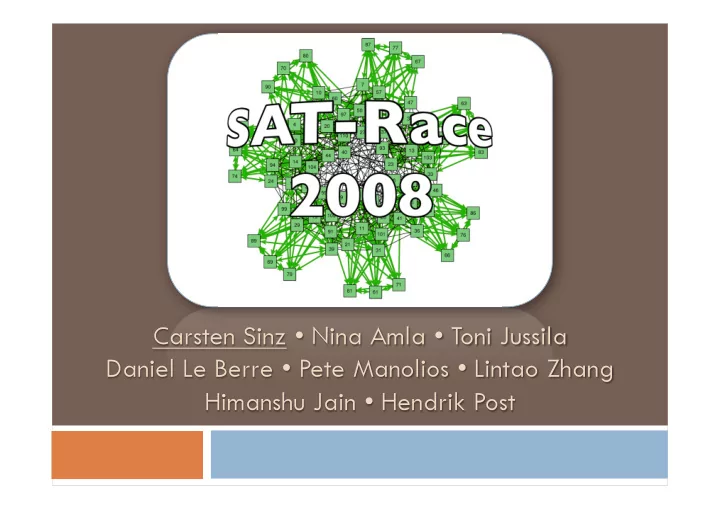

What is SAT-Race? „Small SAT-Competition“ Only industrial category benchmarks (no handcrafted or random) Short run-times (15 minutes timeout per instance) Mixture of satisfiable / unsatisfiable instances (thus not suitable for local-search solvers) „Black-box“ solvers permitted New this year: Special tracks for multi-threaded (parallel) solvers and AIG solvers
Organizers Chair Carsten Sinz (Universität Karlsruhe Germany) Advisory Panel Nina Amla (Cadence Design Systems, USA) Toni Jussila (OneSpin Solutions, Germany) Daniel Le Berre (Université d'Artois, France) Panagiotis Manolios (Northeastern University, USA) Lintao Zhang (Microsoft Research, USA) AIG Special Track Co-Organizer Himanshu Jain (Carnegie Mellon University, USA) Technical Organization Hendrik Post (Universität Karlsruhe, Germany)
Solvers Received 43 solvers by 36 submitters from 16 nations (SAT-Race 2006: 29 solvers by 23 submitters) Australia 2 Netherlands 1 Austria 2 N. Ireland 1 Canada 7 P.R. China 1 Finland 1 Russia 1 France 4 Spain 1 Germany 4 Sweden 4 India 1 USA 8 Israel 2 UK 2 9 industrial solvers, 34 academic 27 solvers in Main Track, 8 in Parallel Track, 8 in AIG Track
Qualification Two qualification rounds Each consisting of 50 benchmark instances Increased runtime-threshold of 20 minutes Successful participation in at least one round required to participate in SAT-Race To ascertain solver correctness and efficiency 1st round took place after February 10, 2nd round after March 12
Results Qualification Rounds Qualification Round 1: 15 solvers already qualified for SAT-Race (by solving more than 40 out of 50 instances) 9 in Main Track, 1 in Parallel Track, 5 in AIG Track Qualification Round 2: 11 solvers additionally qualified (by solving more than 20 out of 50 instances) 8 in Main Track, 2 in Parallel Track, 1 in AIG Track Overall result: 25 (out of 43) solvers qualified 17 in Main Track, 3 in Parallel Track, 6 in AIG Track One solver withdrawn
Qualified Solvers: Main Track Qualified Solvers: Main Track Solver Author(s) Affiliation Barcelogic Robert Nieuwenhuis et al. Tech. Univ. Catalonia Clasp Torsten Schaub et al. University of Potsdam CMUSAT Himanshu Jain CMU eSAT Said Jabbour et al. CRIL Lens / Microsoft Eureka Vadim Ryvchin, Alexander Nadel Intel kw Johan Alfredsson Oepir Consulting LocalMinisat Vadim Ryvchin, Ofer Strichman Technion MiniSat Niklas Sörensson, Niklas Een Independent / Cadence MXC David Bregman, David Mitchell SFU picosat Armin Biere Johannes Kepler University Linz preSAT Cédric Piette et al. CRIL-CNRS / Microsoft Rsat Knot Pipatsrisawat, Adnan Darwiche UCLA SAT4J2.0 Daniel Le Berre CRIL-CNRS SATzilla Lin Xu et al. UBC Spear Domagoj Babic UBC Tinisat Jinbo Huang NICTA
Qualified Solvers: Special Tracks Parallel Solvers: Solver Author(s) Affiliation ManySat Youssef Hamadi Microsoft Research MiraXT Tobias Schubert et al. University of Freiburg pMiniSat Geoffrey Chu University of Melbourne AIG Solvers: Solver Author(s) Affiliation CMUSAT-AIG Himanshu Jain CMU kw_aiger Johan Alfredsson Oepir Consulting MiniCirc Niklas Eén, Niklas Sörensson Cadence Research / Independent MiniSat++ Niklas Sörensson, Niklas Eén Independent / Cadence Research NFLSAT Himanshu Jain CMU Picoaigersat Armin Biere Johannes Kelper University Linz
Benchmark Instances: Main / Parallel Track 20 instances from bounded model checking IBM’s benchmark 2002 and 2004 suites 20 instances from pipelined machine verification 10 instances from Velev’s benchmark suite 10 instances from Manolios’ benchmark suite 10 instances from cryptanalysis Collision-finding attacks on reduced-round MD5 and SHA0 (Mironov & Zhang) 10 instances from software verification C bounded model checking 40 instances from former SAT-Competitions (industrial category) Up to 11,483,525 variables, 32,697,150 clauses Smallest instance: 286 variables, 1742 clauses
Sizes of CNF Benchmark Instances
Benchmark Instances: AIG Track 9 Groups of Benchmark Sets: Anbulagan / Babic / C32SAT / Mironov-Zhang / IBM / Intel / Manolios / Palacios / Mixed Instances mainly from last year’s AIG Competition Additional instances provided by Himanshu Jain and Armin Biere
Parallel Track: Special Rules Run-times for multi-threaded solvers have high deviations (especially for satisfiable instances) 3 runs of each solver on each instance Median run-time is taken as result Instance is considered as solved, if it could be solved in at least 1 out of 3 runs.
Scoring (for sequential tracks) Solution points: 1 point for each instance solved in 1. ≤ 900 seconds Speed points: 2. p max = x / #successful_solvers p s = p max ⋅ (1 – t s / T ) with x set to the maximal value s.t. p s ≤ 1 for all solvers and instances
Computing Environment Linux-Cluster at University of Tübingen 16 compute nodes 2 Intel Xeon 5150 Processors (Dual-Core, 2.66 GHz) per node 8 MB main memory per node Both 32-bit and 64-bit binaries supported Sequential/AIG Track: only one core per solver Parallel Track: 4 cores per solver
Results
Main Track (CNF Sequential) 1 2 3 84.61 points, 88.26 points, 82.10 points, 79 solved instances 81 solved instances 77 solved instances next best solver 81.04 points
Runtime Comparison: Main Track
Special Track 1 (CNF Parallel) 1 2 3 85 solved instances 90 solved instances 73 solved instances
Runtime Comparison: Parallel Track
Special Track 2 (AIG Sequential) 1 2 3 82.80 points, 86.98 points, 82.29 points, 69 solved instances 74 solved instances 70 solved instances next best solver 81.85 points
Runtime Comparison: AIG Track
Lessons Learned Parallel solvers have not yet reached the quality of sequential solvers 2 out of 5 solvers had to be rejected due to erroneous results Assessment of parallel solvers harder due to high runtime deviation 32-bit vs. 64-bit: no clear advantage for either architecture 32-bit: MiniSat; 64-bit: pMiniSat, Barcelogic Preprocessors are vital for large industrial instances
Conclusion Any Progress compared to SAT-Competition 2007? SAT-Race 2008 winner can solve 6 more instances than SAT- Competition 2007 winner (SAT+UNSAT Industrial Category) Four solvers out-perform SAT-Competition 2007 winner Third best solver of SAT-Competition 2007 would have reached place 17 only New ideas for implementation, optimization See solver descriptions on Poster Session this afternoon Many new solvers but mostly slight variants of existing solvers
Recommend
More recommend